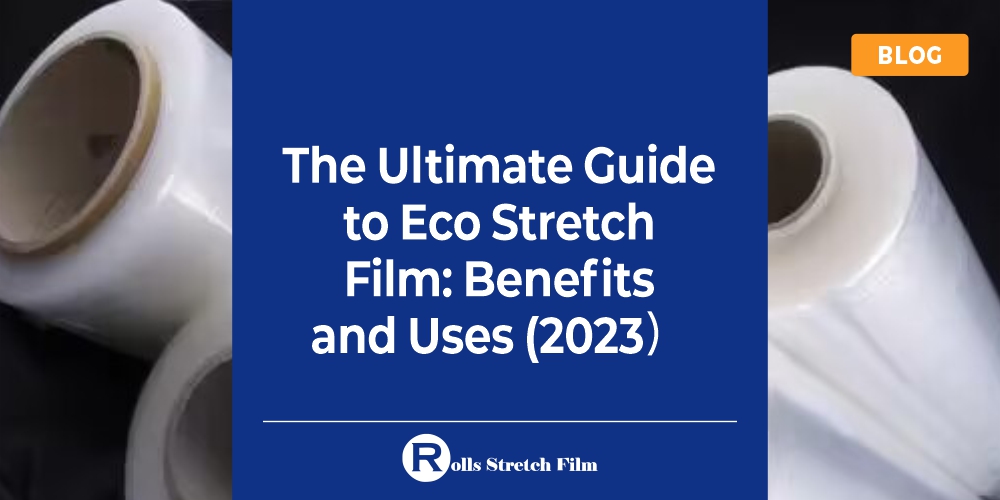Have you ever questioned the environmental impact of the stretch films you use for packaging? You’re not alone. As the world becomes increasingly eco-conscious, the need for sustainable alternatives in the packaging industry has never been more urgent. The problem is real: traditional stretch films contribute to plastic waste, affecting both land and marine ecosystems.
Look no further: Eco Stretch Film is the solution you’ve been searching for. Made from biodegradable or recycled materials, these films provide the same strength and flexibility as conventional stretch films but with a fraction of the environmental impact. By making the switch, you’re not just making a wise business decision but also taking a significant step toward reducing your carbon footprint.
I was wondering what else this innovative product has to offer. Read on to explore its myriad benefits and diverse applications, and prepare to make a lasting change for the better.
Understanding Eco Stretch Film

Eco Stretch Film is an innovative alternative to conventional plastic stretch films often used in packaging. Unlike traditional films, which are mainly made from non-biodegradable materials, eco-stretch movies come from biodegradable, compostable, or recycled materials. These films maintain the essential properties you’d expect from a stretch film—such as tensile strength, elongation, and puncture resistance—but they do so while minimizing environmental impact.
Having been involved in the packaging sector for years, I’ve seen firsthand how impactful a seemingly minor change can be. The efficacy of these eco-friendly films is not just theoretical; I’ve observed it in real-world applications. For those concerned about performance, rest assured: these films are rigorously tested to meet industry standards and hold up remarkably well.
How Eco Stretch Film is Made
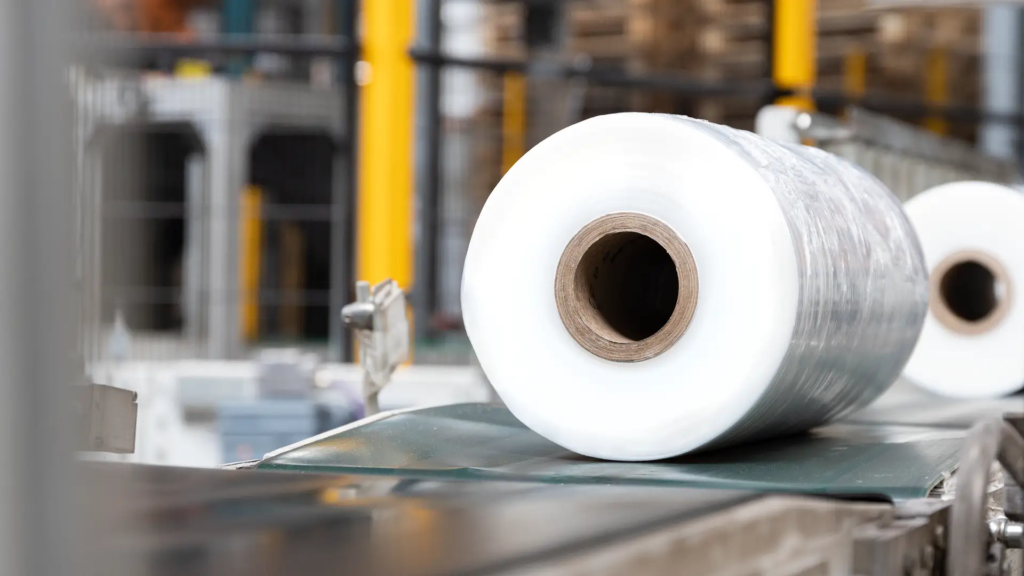
The production of eco-stretch films often involves using biodegradable resins or recycled post-consumer waste. Typically, the material undergoes extrusion, which melts the raw material and shapes it into a thin film. It then gets cooled and wound onto rolls. Some eco-stretch films use renewable resources like cornstarch, reducing their carbon footprint.
The manufacturing process is something I’ve had the opportunity to witness, and the stringent quality controls in place ensure that these films are not just eco-friendly but also reliable and effective. So you’re making an ethical choice and a smart business one, too.
4 Types of Eco-Stretch Film
There are several types of eco-stretch films available in the market, each catering to specific needs:
- Biodegradable Stretch Film: Made from materials that break down naturally over time.
- Recycled Stretch Film: Manufactured using post-consumer waste, often a mix of pre-and post-consumer recycled content.
- Compostable Stretch Film: These films can be composted and will degrade within a composting environment in weeks.
- Renewable-Based Stretch Film: Produced using renewable resources like cornstarch or sugarcane.
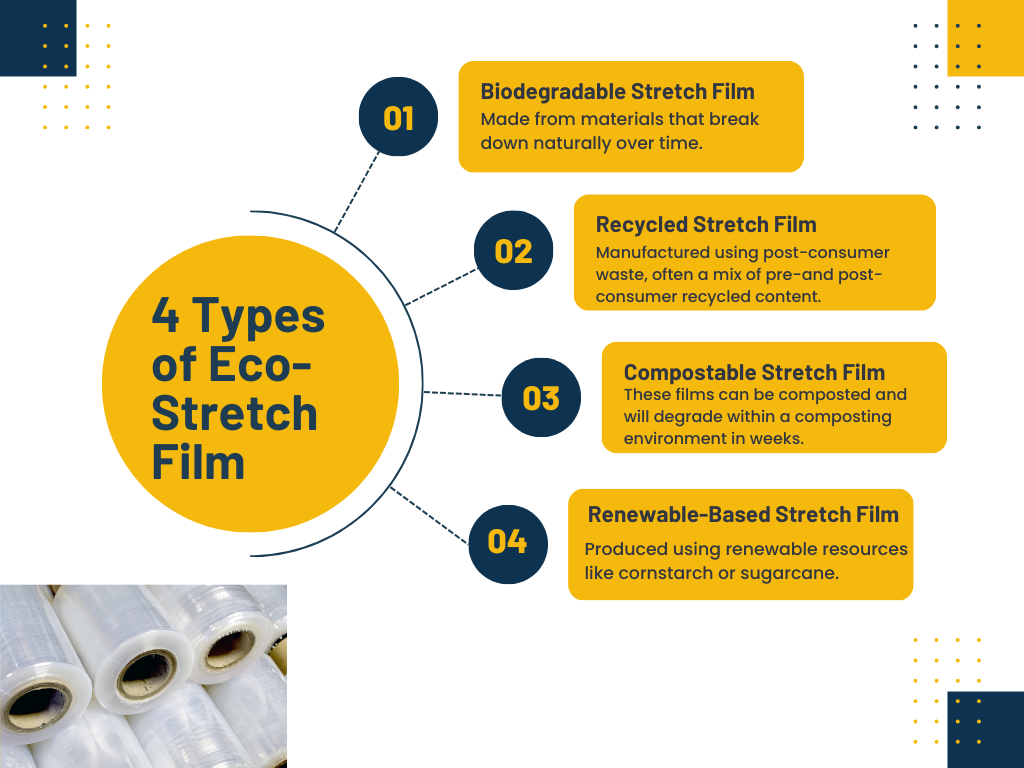
The Benefits of Using Eco Stretch Film
Environmental Benefits
- Reduction of Plastic Waste
One of the most immediate benefits of using eco stretch film is the substantially reduced plastic waste. Traditional stretch films often end up in landfills and oceans, contributing to pollution and harming wildlife. By switching to eco-friendly options, you’re taking a proactive step to minimize waste and its harmful effects. I’ve seen the difference it makes in waste statistics and a sense of responsibility among my clients and colleagues.
- Lowers Carbon Footprint
Another significant advantage is the reduction in your carbon footprint. Because these films are often made from renewable or recycled materials, their production typically requires less energy. Having studied the life cycles of various packaging materials, eco-stretch stretch films are a solid choice for those looking to be more responsible stewards of the environment.
Economic Benefits
- Cost-effectiveness
It’s a misconception that eco-friendly alternatives are invariably more expensive. In many cases, eco-stretch films’ unit cost is comparable to traditional cinema’s. Also, as demand for eco-friendly solutions grows, economies of scale will likely make them even more affordable. I’ve guided multiple companies through this transition, and they were pleasantly surprised by how cost-effective the shift can be.
- Reduction in Waste Management Costs
When you use biodegradable or recyclable stretch films, the costs associated with waste management can also be reduced. Fewer requirements for specialized disposal mean you can divert funds to other areas of your business. It’s a win-win from both an ethical and an economic perspective.
Operational Benefits
- Improved Product Protection
Don’t let the “eco-friendly” tag fool you into thinking these films are any less effective at their primary job—protecting your products. These films undergo rigorous testing to ensure they meet industry standards for strength and durability. I’ve consulted on packaging solutions for various industries, and eco-stretch films consistently deliver reliable performance.
- Versatility of Use
Finally, eco stretch films are versatile and can be used in a multitude of settings, from wrapping pallets in large warehouses to packaging food products. The adaptability of these films is something I’ve appreciated in multiple logistical challenges; they meet a wide range of requirements without compromising on quality or environmental impact.
When you decide to integrate eco-stretch film into your operations, you’re making a choice that’s good for the planet, your bottom line, and your operational efficiency. The numerous benefits make this a straightforward decision for businesses aiming to align profitability with sustainability.
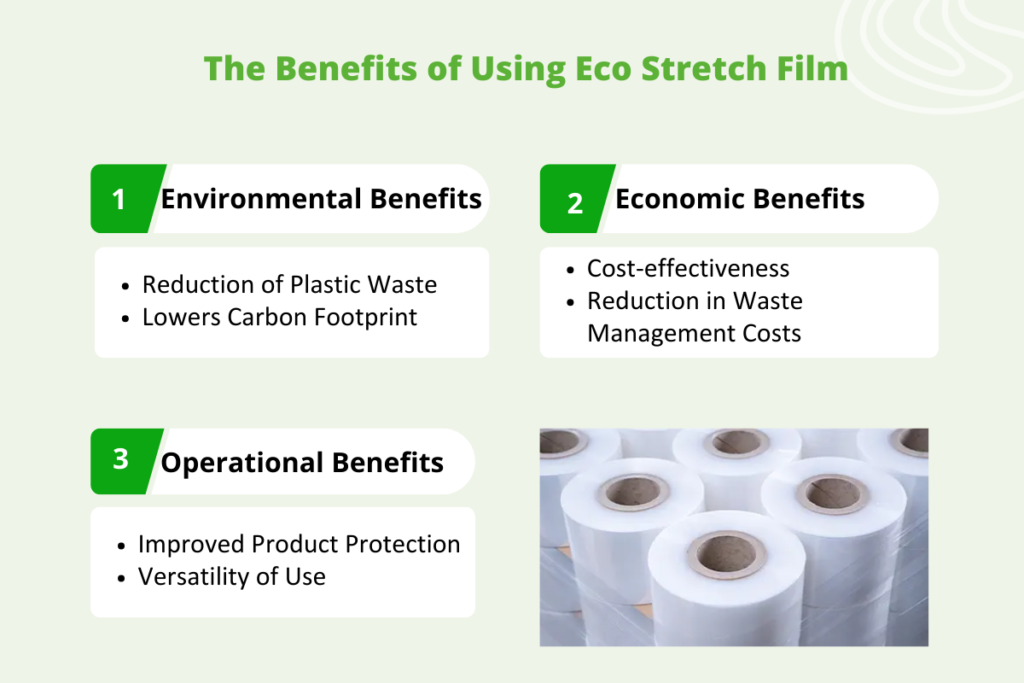
Common Uses of Eco Stretch Film
Packaging and Transport of Goods

Perhaps the most widespread use of eco stretch film is in the packaging and transporting of goods. From warehouses to retailers, this material ensures that products reach their destination in pristine condition. Given its tensile strength and durability, eco-stretch film is ideal for wrapping pallets and securing items during transit. Through my years in the industry, I’ve overseen countless shipments where eco-stretch films played a critical role in the efficient and eco-friendly delivery of goods.
Food Preservation

Another crucial application is in the realm of food preservation. Traditional plastic films are often used to wrap fruits, vegetables, and other perishables, but eco-stretch films offer a more sustainable alternative without sacrificing quality. These films keep your food fresh while ensuring that you’re not contributing to plastic waste. Having helped clients in the food industry transition to sustainable packaging, I can affirm the efficacy of eco-stretch films in preserving both the product’s freshness and the planet’s health.
Agriculture and Gardening

Eco stretch films are not limited to the industrial sector; they’re also incredibly useful in agriculture and gardening. For example, they can be used to wrap bales of hay or even to secure young trees and plants against strong winds. These applications are particularly appealing because the film eventually breaks down, enriching the soil rather than polluting it. I’ve advised several agricultural operations on making this transition, and the operational and environmental benefits are immediately apparent.
Other Innovative Uses
In a testament to its versatility, eco-stretch film continually finds new applications. Some companies are experimenting with using it for temporary outdoor structures and even as an alternative to more harmful materials in crafting and arts. The adaptability of eco-stretch films to various contexts makes it a go-to choice for innovators looking to marry function and sustainability.
The applications for the eco-stretch film are eco-stretch and thoroughly evaluate your current packaging processes across multiple sectors, proving its worth as an environmentally responsible choice and an efficient and versatile material. Whether you’re involved in industrial shipping, food retail, or even artistic endeavors, there’s an eco-stretch film that can meet your needs while aligning with the greater good.
Making the Transition to Eco Stretch Film: Practical Steps for Businesses
Evaluating Current Packaging Processes
The first step in the transition is to evaluate your current packaging processes thoroughly. This involves not just cost assessment but also an examination of the environmental impact of your existing materials. Upon careful review, I’ve found that most businesses realize there’s room for improvement in eco-friendliness and operational efficiency.
Choosing the Right Type of Eco-Stretch Film
Given the variety of eco-stretch films available in the market, choosing one that best suits your specific needs is crucial. This could mean selecting a biodegradable option for perishables or a more durable, recycled material for heavy industrial goods. From my experience in helping businesses navigate this choice, I can say that a bit of research and consultation can go a long way in making an informed decision.
Collaborating with Suppliers and Customers
Transitioning to eco-stretch film isn’t a solitary endeavor; it often involves collaborating closely with suppliers and customers. Open communication about why you’re making the switch can improve your business relationships and potentially influence others in your supply chain to adopt more sustainable practices. In my various roles, promoting such collaborations has often led to win-win scenarios for everyone involved.
Monitoring and Adjusting the Transition Process
Once the transition is underway, it’s imperative to monitor the results. This includes regularly assessing the environmental impact, cost-effectiveness, and operational challenges. Just like any other aspect of business, it may require some adjustments along the way. Having been a part of several such transitions, I can attest to the value of continuous monitoring and adjustment to ensure the move is beneficial on multiple fronts.
The shift to using eco-stretch film in your operations is more than a mere switch of materials; it’s an investment in a more sustainable and potentially efficient future. With careful planning, collaboration, and ongoing evaluation, businesses can successfully make this transition, benefiting their bottom line and the planet.
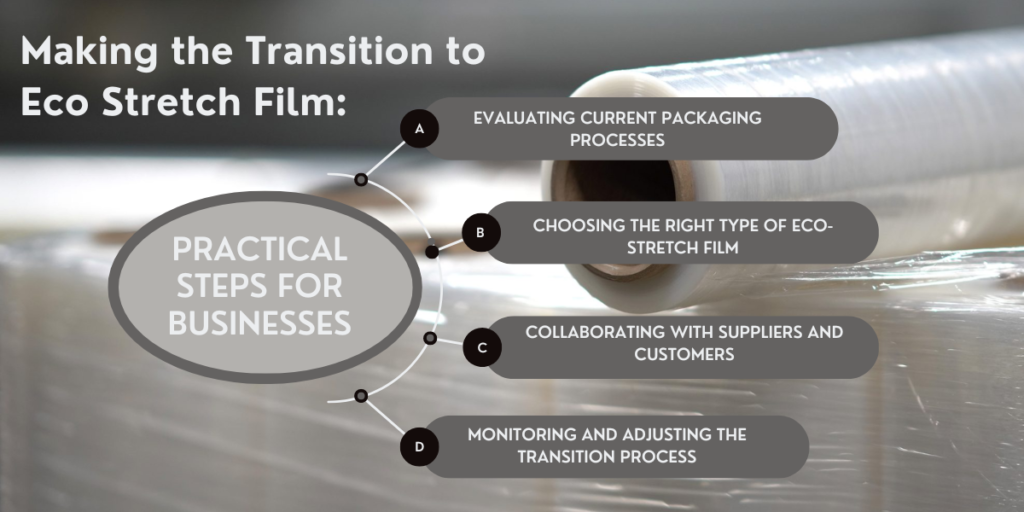
Conclusion
Eco stretch film is a multifaceted solution that offers environmental, economic, and operational advantages. Its benefits are broad and significant, from reducing plastic waste and lowering carbon footprint to offering cost-effectiveness and versatility in applications ranging from packaging to agriculture. Having guided businesses through this transformative shift, I can affirm the value it brings both to companies and the planet.
It’s time for more businesses to make this transition. By taking these practical steps, you’ll invest in your company’s future and contribute to global sustainability efforts. Don’t wait; the time to act is now.

